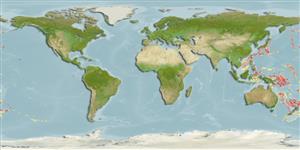Klassifizierung / Names
Namen | Synonyme | Catalog of Fishes(Gattung, Arten) | ITIS | CoL | WoRMS | Cloffa
>
Perciformes/Zoarcoidei (Eelpouts and pricklebacks) >
Zoarcidae (Eelpouts) > Lycodinae
Etymology: Pyrolycus: Greek, pyr = fire + Greek, lykos = wolf (Ref. 45335); manusanus: Named for its type locality, Manus Basin..
Environment: milieu / climate zone / depth range / distribution range
Ökologie
seewasser bathydemersal; tiefenbereich 1623 - 1971 m (Ref. 41628). Deep-water
Western Central Pacific: Papua New Guinea.
Size / Gewicht / Alter
Maturity: Lm ? range ? - ? cm
Max length : 17.1 cm SL Männchen/unbestimmt; (Ref. 41628)
Kurzbeschreibung
Bestimmungsschlüssel | Morphologie | Morphometrie
Wirbelzahl: 78 - 81. Flesh gelatinous. Head without dermal papillae. Gill slit large, extending ventrally beyond the pectoral fin absent. Suborbital bones 6; canal with 6-7 pores. Postorbital pores 3; occipital 1. Palatopterygoid series weak. Scales, lateral line and pseudobranch absent.. Teeth on vomer and palatine present. Caudal fin rays 8-10 (Ref. 41628).
Stomach contents include bresiliid shrimps. A 12.46 cm SL female specimen had about 600 eggs of various size, up to 0.4 mm in diameter; another 17.2 cm SL female with about 650 eggs of various size, up to 1.0 mm in diameter (Ref. 41628).
Life cycle and mating behavior
Maturities | Fortpflanzung | Spawnings | Egg(s) | Fecundities | Larven
Machida, Y. and J. Hashimoto, 2002. Pyrolycus manusanus, a new genus and species of deep-sea eelpout from a hydrothermal vent field in the Manus Basin, Papua New Guinea (Zoarcidae, Lycodinae). Ichthyol. Res. 49(1):1-6. (Ref. 41628)
IUCN Rote Liste Status (Ref. 130435)
Bedrohung für Menschen
Harmless
Nutzung durch Menschen
Tools
Zusatzinformationen
Download XML
Internet Quellen
Estimates based on models
Preferred temperature (Ref.
123201): 2.3 - 2.7, mean 2.6 °C (based on 68 cells).
Phylogenetic diversity index (Ref.
82804): PD
50 = 0.7500 [Uniqueness, from 0.5 = low to 2.0 = high].
Bayesian length-weight: a=0.00120 (0.00057 - 0.00252), b=3.10 (2.91 - 3.29), in cm total length, based on LWR estimates for this (Sub)family-body shape (Ref.
93245).
Trophic level (Ref.
69278): 3.6 ±0.59 se; based on food items.
Widerstandsfähigkeit (Ref.
120179): mittel, Verdopplung der Population dauert 1,4 - 4,4 Jahre. (Preliminary K or Fecundity.).
Fishing Vulnerability (Ref.
59153): Low vulnerability (11 of 100).
